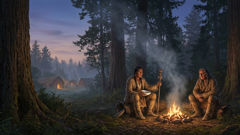Introduction
On the windy ridges where the clouds linger like a second sky, and in valleys where orchids lean toward the mist, the Madremonte wakes at dusk. Her name—Mother Mountain—carries both reverence and warning in the mouths of farmers, hunters, and children who play in the shadow of the Andean slopes. She is said to be older than the oldest tree, older than the first trail cut by human foot, and though her form shifts like fog, the stories hold a core truth: the land has a guardian that will not abide wanton destruction. Some elders say she was born of neglected promises, a response to the first axes that bit into ancestral trunks; others call her an ancient earth mother, a being woven from roots, moss, and the breath of the mountain itself. Whether she is an ancestral spirit, a personified law of nature, or an embodiment of communal conscience, the Madremonte binds culture and ecology, memory and landscape. When the wind hums through the pines and the frogs chorus at the river’s bend, mothers hush their children and remind them of the rules: do not call her by her true name; do not take from the forest without leaving an offering; respect the trails, or she will cover them. This myth threads through towns and haciendas, markets and schoolrooms. It is told to coax reverence from the young and to shame the greedy. Modern conservationists find in her story a persuasive voice: a myth that carries ecological urgency without the bluntness of policy. As the country negotiates roads, plantations, and extractive industry, the Madremonte remains a living narrative, a cultural artifact and a plea. She is at once protector and punisher—capable of guiding lost hunters home by the light of a phosphorescent flower, and capable of luring those who cut her trees into dense, inescapable tangles. This is a story of the Madremonte’s origins and appearances, of how communities have known and negotiated her presence, and of how a mountain spirit shaped a people’s relationship with their land, offering both a mythic past and a practical ethic for the future.
Origins, Names, and Regional Voices
The Madremonte appears in whispers and in the booming cadences of village tales; her name adapts across valleys—Madremonte, Madre Monte, Marimonda in some retellings, and sometimes Mother Mountain in Spanish-speaking schools and tour guides. Her origins are composite: indigenous cosmovisions that personify the land meet the vocabularies of colonial history and rural Catholic admonishments. In the high páramos and cloud forests of the Colombian Andes, mothers told of her to keep children from wandering after dark. In lowland foothills, loggers recall the sudden fogs that close round illegal camps, separate men from their tools, and push them back toward the trails they had abandoned. These variations are not contradictions but local dialects of the same imperative: nature must be respected.

Scholars and storytellers often trace the Madremonte to pre-Columbian reverence for earth and spirit, where mountains themselves were considered ancestral presences. The mountain was not merely rock and soil; it was kin. With the arrival of new settlers and the expansion of agriculture, the character of that kinship shifted into more cautionary tales. Where indigenous guardians once negotiated relationships with humans through reciprocal offerings—seed, tobacco, song—the newcomers brought axes, fires, and a worldview that commodified timber. The stories evolved. A figure who once accepted gifts and reciprocated with fertility became a stern enforcer; ritual became warning. In remote communities the ritual forms persisted: a small offering left at a stream, an elder walking a boundary and calling the names of the trees aloud, children taught to speak soft words into the forest so as not to wake her anger.
Descriptions of the Madremonte are numerous and resonant: she is often envisioned as a towering woman whose body is composed of bark and leaf, hair braided with vines and orchids, a hem that trails into moss and ferns. In some tellings her eyes are the pale blue of cloud shadows, in others they are the deep green of virgin canopy. Her voice is said to sound like wind through bamboo, or the distant thunder that announces a coming storm. Her footprints leave rings of mushrooms or sudden patches of fertile moss. More menacing versions emphasize her ability to shape-shift: she becomes a white-haired old woman, a luminous deer, or simply a patch of dense fog that slips between trees. To those who harm the forest, she appears as a vindictive force that breaks tools, leads men astray, and entangles hunters in thorny thickets until they forget their way home.
The Madremonte also has less fearsome duties in the stories. She is guardian of wild animals and hidden springs; she tends suffering trees and nurses saplings back to health. When miners dig without ceremony or when ranchers burn away corridors of forest for pasture, villagers recall the time-honored punishments: sudden storms that drown fields, swarms of biting insects that devastate crops, or inexplicable illnesses. These penalties functioned as a form of communal law long before formal institutions regulated land use. The Madremonte’s presence codified a moral economy of reciprocity: take only what you need, give thanks, and leave offerings. If you broke those rules, the mountain would balance the ledger.
Throughout Colombia’s regions, the figure adapts to local flora and fauna. In the humid lowland forests, she is associated with ceiba and guadua; in higher cloud forests, with frailejones and wax palms; along rivers, she protects fish and freshwater springs. Local ceremonies—small, quiet, and often private—still acknowledge her. Farmers may tie a colored ribbon to a young tree, sing a verse before planting, or spare a particular grove as sacred. These practices have ecological consequences: saved groves become seed banks, shelters for wildlife, and microclimates that stabilize soil and water cycles. Oral histories reveal that the myth operates as informal governance: it establishes taboo spaces where the forest recovers and grows.
In the modern era, as roads push deeper into previously remote terrain and global demand for timber and land intensifies, the Madremonte’s warnings have confronted a new reality. Conservationists have sometimes invoked her in community education, not as a relic of superstition but as a culturally resonant voice that can mobilize local stewardship. Anthropologists record the way elders still tell tales to children before they leave the village to work in distant towns, reminding them that the mountain remembers. Tour guides string the stories into itineraries for visitors, translating ritual offerings into bilingual explanations of biodiversity and land rights. Where industry and development enter these landscapes, the Madremonte’s story becomes a means to reassert communal values, to argue that a place is not just a parcel of land for sale but a living system with relationships that cannot be easily bought or sold.
The iconography of the Madremonte—rooted in the sensory world of forests: the smell of earth after rain, the slick shine of mushrooms, the neon flash of poison dart frogs—anchors the tale in experiential detail. It is this sensory richness that makes the myth persuasive; listeners do not merely hear about rules, they feel the damp air on their skin, see the halo of fungus at a root, and sense the hush that falls when an elder speaks. Because the myth travels across time and place, it has become not a single story but a network of stories: each grove has its own version, each town a slightly different melody. Yet across all versions, one consistent strand persists: the land demands respect, and the Madremonte ensures that respect is not optional.
Language—song, warning, blessing—matters in stories of the Madremonte. It is often said that she is less moved by strength than by humility; those who approach with reverence can pass, sometimes even receive guidance, while those who strike and take are bound to face consequences. This emphasis on relational ethics aligns closely with ecological science: sustainable use requires restraint, localized knowledge, and reciprocal practices. The myth, in many ways, encodes a management regime that protected biodiversity long before modern conservation frameworks emerged. As Colombian society negotiates the demands of economic development and ecological conservation, the Madremonte remains a living moral compass, a story with roots deep enough to shape both land and law.
Encounters, Lessons, and Modern Relevance
Stories of encounters with the Madremonte range from the gentle to the terrifying. In one coastal foothill town, an old hunter named Tomás wandered off the trail during a dry season, following the call of a capybara. He crossed a recently cleared patch of land and soon found that his footsteps sank into an unseasonal, spongy soil where he had expected hard-packed earth. Mist thickened around his ankles and a woman-shaped shadow stood between two pines. Her voice, when she spoke, sounded like rain on tin. Tomás, who had come to the forest with an illegal shot, felt an unexpected rush of guilt. He remembered the stories: do not take what you do not need; leave an offering. He knelt, laid down his cartridges, and murmured an apology. The shadow lifted and a path reopened, leading him back to his village. The elders say Tomás never again hunted beyond what his family needed, and he began to bring offerings to the streams—cassava, a pinch of tobacco, a song—each year when the rains began.

In a harsher vignette, a logging crew from a distant town felled an elder tree considered sacred by local families. Over the following nights, tools were lost and found in impossible places; men reported seeing a young woman picking berries at dusk who vanished when approached. One foreman ignored the stories, dismissing them as superstition. Within weeks, several workers became ill with fevers of a peculiar kind, or they suffered inexplicable injuries that were impossible to trace to any machine. Some families left the work and refused to return. The crew broke camp and abandoned their plans. Whether these consequences were the workings of the Madremonte herself or the social power of a community rallying to make the place unworkable, the result aligned with the myth’s purpose: to discourage wanton destruction and to protect sacred groves.
There are also subtler tales that reveal how the myth functions as knowledge transfer. Midwives in certain mountain villages still refer to a story in which the Madremonte guided a lost, laboring woman back to her family, leading the way by brushing aside low branches to reveal a hidden trail. In such stories, the Madremonte acts as guardian not only of trees but of people who respect the land. These accounts often serve practical ends: they teach the routes of safe passage, mark the locations of freshwater springs, and transmit ecological indicators that a place is healthy or sick. A storyteller will describe how certain orchids only bloom after a specific rain cycle, or how the call of a particular bird warns of approaching predators. Embedded in this narrative knowledge is detailed ecological information—seasonal markers, medicinal plants, and soil patterns—that helps a community survive.
The modern encounter with the Madremonte is complicated by commercialization and tourism. In ecotourism brochures, the myth can be commodified: a romantic figure used to attract visitors seeking an “authentic” mystical experience. While tourism can generate funds for conservation and provide economic alternatives to extractive industries, it can also erode the moral authority of the myth if the tale is reduced to a costume and a photo opportunity. Many communities navigate this tightrope by combining interpretive tours with local guardianship: guides tell the story of the Madremonte while also teaching rules—no off-trail hiking, no picking orchids, no leaving trash. In some places, entrance fees and tourist education programs are partly justified by the story of the Madremonte, ensuring that visitors contribute to the stewarding of fragile ecosystems.
At a political level, the Madremonte has occasionally entered debates over land rights and environmental justice. Indigenous and campesino communities have invoked ancestral guardianship as a rhetorical and legal tool to defend territories from extractive projects. The myth provides a language that links ecological care to cultural survival; it asserts that certain trees and groves are not mere resources but relations. When communities bring these perspectives into courtrooms, environmental impact studies, or meetings with companies, the Madremonte’s narrative functions as both cultural testimony and moral pressure. The image of a Mother Mountain that refuses to be plundered resonates beyond superstition: it articulates an ethic of commoning the land and a demand for decisions that consider long-term ecological balance.
Education programs have found inventive ways to integrate the Madremonte into curricula. Teachers use the story to introduce students to ecology, hydrology, and sustainable agriculture. Folktales about the Madremonte become launch points for projects where children map their local watersheds, record species, and practice seed-saving. By combining myth and science, educators help students grasp that cultural narratives carry empirical insight: a taboo grove often harbors rare species; a forbidden pond might be a key breeding ground for fish and amphibians. This blending restores agency to communities, giving them frameworks to steward their territories while resisting harmful economic pressures.
The myth also adapts to climate change. Where once the Madremonte might punish a single transgression, now communities face slow, systemic threats: shifting rainfall patterns, prolonged droughts, and invasive agricultural systems. The narrative of a guardian who enforces reciprocity can be reframed: not as a punitive figure but as a symbol of the need for collective action. In workshops, activists might invoke the Madremonte to galvanize reforestation, to protect headwaters, or to design landscape-level conservation strategies. The symbolism is powerful precisely because it resonates across generations: invoking the Madremonte is to call on ancestral wisdom to address contemporary crises.
Encounters with the Madremonte are thus not merely tales of fear; they are modes of social regulation, mnemonic devices for ecological knowledge, and tools for political solidarity. Whether she appears in a hush of leaves, a sudden fog, or as a woman with moss for hair, her presence compels a reckoning: how will humans live in relation to the mountain and its forests? The breadth of stories—gentle guidance for those who honor her rules, harsh penalties for the extractive and careless—reveals an ethic that balances use with responsibility. In practice, this ethic has protected seed sources, preserved critical habitats, and sustained livelihoods. As Colombia moves forward amid competing visions of development, the Madremonte’s tale remains a living repository of values that insist the mountain be treated as kin, not commodity.
Conclusion
The Madremonte is more than a ghost story told to frighten children into coming home before dark; she is a practical ethics, a cultural institution, and a living metaphor for ecological awareness. Across valleys and cloud forests, her myth has encouraged behaviors that support biodiversity: leaving offerings, sparing sacred groves, and honoring seasonal cycles. Her punishments—whether interpreted as literal supernatural retribution or as the social and ecological consequences of exploitation—have long discouraged unsustainable extraction. In an era of accelerating climate change and expanding development, the Madremonte’s message feels urgent: the land remembers and it reacts when hurt. By taking this myth seriously—by listening to its variations and learning the ecological knowledge embedded within—communities and policymakers can rediscover pathways to stewardship that are culturally anchored and ecologically effective. The Mother Mountain invites a shift from dominion to kinship: treat the forest as relation, not resource. If we heed her stories, we might keep our waters flowing, our soils stable, and our mountains singing for generations to come.













